The 2025 Lucky Hearts Poker Open has been announced!
The series runs from January 9 -21 with a $2 Million Guaranteed WPT Championship.
Find out More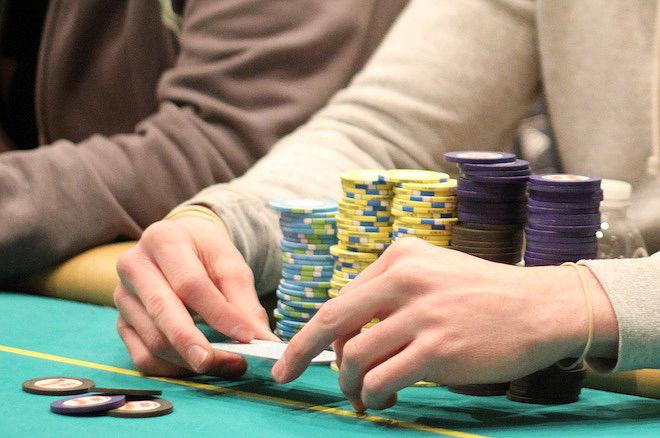
Preflop raising decisions can be very complex. What stakes are we playing? Is it a live game or online? How strong is our hand? Which limpers will call? Will we be in position postflop?
Sometimes our decision is obvious: "I have aces, so I'm going to raise for value here." Sometimes it's subjective: "I think I can force the limper to fold here." But we should also consider what a mathematical analysis of preflop raising can teach us. When is a raise our most profitable action for the moment? When might it be the most profitable action for the hand?
In order to calculate the expected value for our preflop actions accurately, we need to know certain key frequencies that are typical for our game.
Figure 1 below contains some of the most useful stats for these EV calculations for both online NL100 and $1/$2 NL live games in Las Vegas, most of them published here for the first time. (Check out Donkey Poker Volume 2: Postflop, Section 7.5 to see how these stats were generated.)
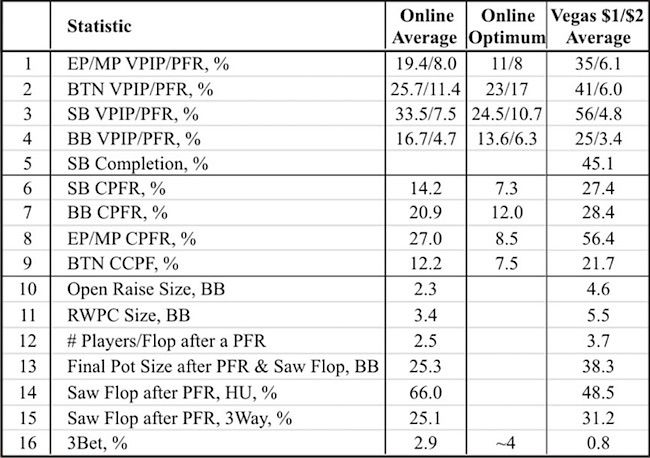
Here I define "EP/MP" as the first four seats after the big blind on a nine-seat table. Since the vast majority of Vegas $1/$2 players are position-dumb, we can combine the results from these seats into a single stat in order to make the stat more reliable. The hijack and cutoff stats are similar to the EP/MP stats.
VPIP and PFR are the primary stats useful to determine an opponent's playing style. "35/6" means that the average Vegas player voluntarily invests in 35 percent of his dealt hands, while raising only 6 percent of them. This player would be considered a "loose-passive" player in an online game, but he is average in a Vegas $1/$2 game.
Calling a Preflop Raise (CPFR) is a statistic that applies only when a player calls a raise after having already invested in the pot, which applies to limp-callers as well as to the blinds. This is not the same thing as Cold Calling Preflop (CCPF).
Compared to an online game, a Vegas preflop raise is fraught with more risk. Not only is our average raise size larger, our Vegas opponents are more likely to call it. Although their calling range is weaker, we often face multiple callers, which is rare online. Consequently, it is extremely important to have a solid idea of how these stats influence the profitability of our preflop action.
Let's consider a situation which is relatively easy to calculate. Suppose an average player limps from one of the EP/MP positions. It folds around to Hero in the big blind who can check his option or raise.
Figure 1 indicates that that Mr. Average has a range of 35 percent, but he normally raises with 6.1 percent of this range. So we can assign his limping range as [6.1–35]. The specific card combos within his range depend on the ranking system we use. Although there is no single ranking system that is always correct, I will use the Flopzilla NLHE ranking in this column, since it is easy for anyone to access.
Suppose Hero has 2♣2♠ and decides to check. We can estimate Hero's "Momentary Expected Value" (MEV) as...
...where Pot0 = $5 and EWC (Showdown Equity When Called) is 47.4 percent for Hero's pocket deuces when facing Villain's range. I call this his "momentary" EV since it applies only at the moment he checks.
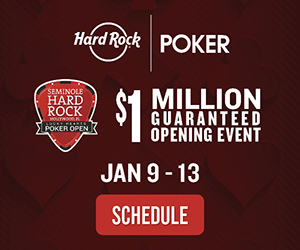
The series runs from January 9 -21 with a $2 Million Guaranteed WPT Championship.
Find out MoreSuppose Hero decides to raise to $10 with the same 2♣2♠. Figure 1 shows that an average villain will call a preflop raise after limping in EP/MP about 56 percent of the time (Row 8). This would be a Flopzilla range of [6.1–22.7].
Hero's Fold Equity is FE = (1 - 0.564) = 0.436. His showdown Equity-When-Called is EWC = 0.454. Notice that even though the villain has folded nearly half of his range, Hero's EWC is only slightly worse than when he checks. This suggests that the villain's actual limping and calling ranges are not critical in establishing Hero's MEV.
After deciding to raise, we can calculate Hero's MEV as...
The first term is just the average amount earned when the villain folds. The second term is the amount earned when the villain calls. " Pot1" is the size of the pot after he calls, minus the rake. "Raise" is the size of our raise ($8 in this case). Since three-betting is so rare in Vegas $1/$2, and limp-three-betting is even rarer, we can ignore it for this calculation. Again, we consider this our momentary EV since it only applies at the end of the preflop action.
So Hero's raise appears to be more profitable (by $0.18) than checking. It gains nearly all of its profitability from fold equity and a just little from showdown equity. This is generally the case for heads-up battles.
However, there is a serious issue with these estimates. MEV uses showdown equity, which essentially assumes that the hand will be checked down postflop. This rarely happens in a real game, which makes its usefulness imperfect. We haven't considered such factors as skill and position, which can increase or decrease our expected profit in the hand. Hero's inferior position in this scenario suggests that his actual "Hand EV" (HEV) will be lower than his calculated MEV. Even Hero's superior skill will not likely overcome his inferior position.
Since Hero's inferior postflop position makes it difficult to realize the full MEV of either action, it's difficult to say which action would have the higher HEV. Hero's best decision could depend on whether the villain appears more or less likely than the average villain to fold to Hero's raise. We might also consider that if both actions result in a similar HEV, the check does so with less risk.
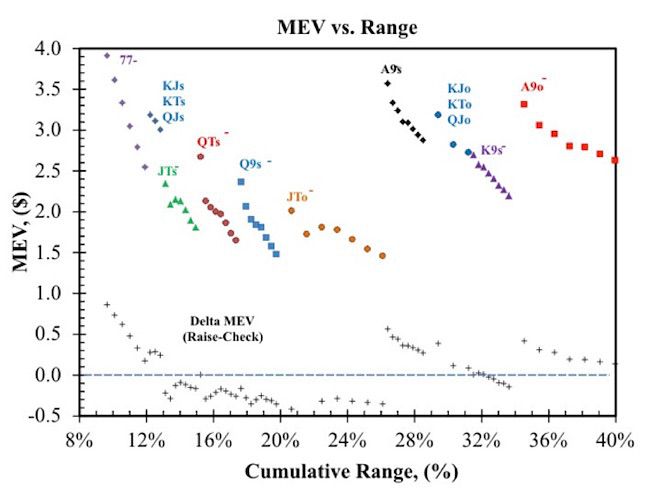
Figure 2 shows the results of these calculations applied to some of the hands listed in the Donkey Poker starting hands chart. The solid symbols represent Hero's MEV when raising to $10, which is positive for each of these combos. "JTs-" denotes "suited connectors JTs and smaller." Meanwhile the "+" symbols represent the difference in MEV between raising and checking.
When MEV is positive, raising is more profitable than checking, which is true for a range including approximately 22+, A2+, KT+, and QJ (i.e., any pocket pair, any ace-x hand, any two Broadway cards). This represents 27.6 percent of all starting hands.
Since we are out of position in the scenario, our HEV is probably lower than these values, so checking is probably preferable when the Delta MEV is close to zero.
The previous scenario is rare in Vegas $1/$2 games, but it serves to illustrate the principals used for our analytical EV calculations. A more common and useful example is when the Hero is on the button with 2♣2♠ and facing a single EP/MP limper. In this case Hero can fold, limp, or raise, where folding has an EVfold = 0.
This calculation has additional complexity because we have the blinds behind us, which means we must consider their propensity to check behind or complete and their propensity to call a raise. (We will ignore their negligible three-betting frequency here.)
Suppose Hero limps and the two blinds raise 4.8 percent and 3.4 percent of the time, respectively. If the small blind completes with [4.8-50] and the big blind has a range of [3.4-100], we will have a four-way pot about 92 percent of the time.
Let's suppose the other 8 percent of the time Hero limp-folds after one of the blinds raises. (This is plausible for those hands with which Hero would actually limp.) We can also assume that the EP/MP limper has a range of [6.1-35.7]. All of these values are based on the actual Vegas stats listed in Figure 1.
We then have...
In other words, limping on the button with 2♣2♠ is not immediately profitable.
Suppose we raise to $10 with 2♣2♠ on the button. Using the above frequencies, everyone will fold 23.1 percent of the time. A single villain will call 47.0 percent of the time, two villains will call 25.7 percent of the time, and everyone will call 4.2 percent of the time.
It turns out our EWC is nearly the same no matter which villain calls, so we can treat each villain as interchangeable. Thus, Hero's MEV is approximately...
...where the various values depend on how many players called our raise. We can see that raising with our pocket deuces is much more immediately profitable than limping with them. Furthermore, our Hand EV should be better than this since we have superior position and skill and since we can leverage our profit when we flop a set.
Note that when the blinds are tight and/or passive, they are less likely to call our raise and less likely to three-bet. (Pre-loading tells are very important here.) In these situations, raising a single limper from the button is even more +MEV. And our HEV is even more enhanced since we are less likely to face multiple villains in a raised pot. (It's generally easier to outplay a single villain than three of them.)
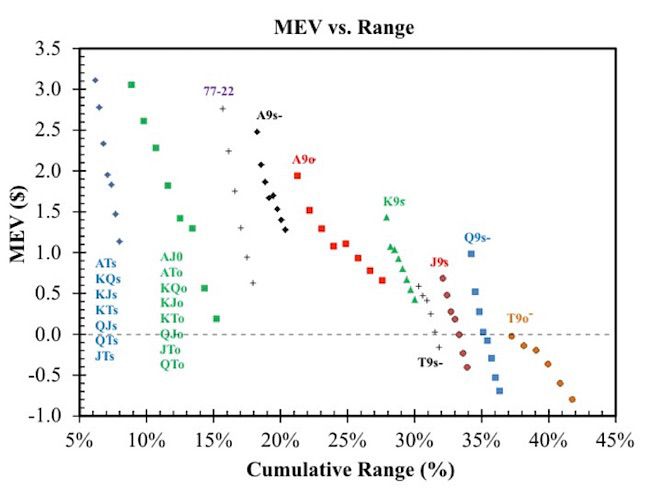
Figure 3 depicts the MEV results for various hand types. The symbols represent the MEV for raising to $10 in a Vegas $1/$2 game. Each series represents a descending hand grouping. For example, "T9s-" denotes "suited connectors T9s and smaller."
Bottom line: in low-stakes cash games such as the $1/$2 NL games in Vegas, raising is nearly always more profitable than limping (except for 63s, 53s, 65o and 54o). In fact, 33 percent of all starting combos are immediately profitable. And some of the negative-MEV combos are probably profitable for the hand due to our superior position.
Since most Vegas $1/$2 players are position-dumb, they generally limp and call with a similar frequency from the hijack and cutoff positions. So our very wide button raising range is valid for any single-limper situation when we are on the button.
The previous single-limper scenario occurs only a small fraction of the time in Vegas $1/$2 games. We can readily extend this to multiple-limper scenarios, which are much more common. This calculation is even more complex and we are less likely to fold everyone out with a $10 button raise. This time I will spare you the gory math and show you the results below in Figure 4.
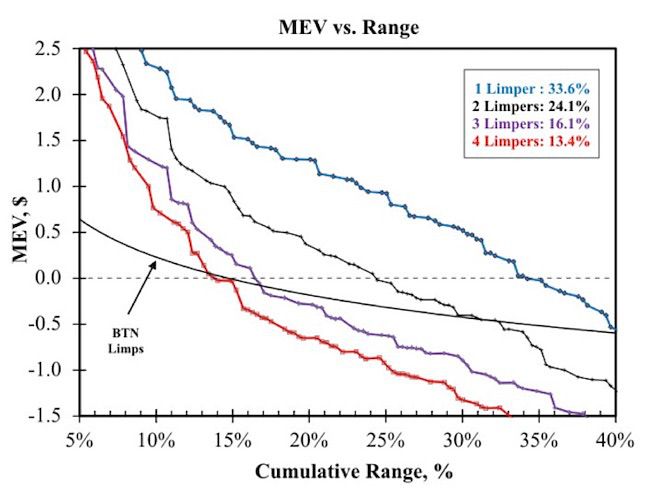
Here the top four curves represent the MEV for raising to $10 facing one, two, three, and four limpers. The smooth line represents the average MEV of limping. These curves show that our "immediately profitable" raising range is 33.6 percent when facing a single limper, and that our range decreases to 13.4 percent when facing four limpers.
We can make several conclusions here:
A typical rule of thumb for these Vegas $1/$2 games is to raise to about 4x BB plus one additional BB for each limper. Thus we would raise to $10, $12, $14, or $16 as the number of limpers increases. The previous analysis kept the raise size constant to see the influence of the number of limpers.
A key question we would like answered is how the villains will respond to reasonable variations in raise size. Unfortunately, that data does not exist for these Vegas games. My general feeling, however, is that most Vegas $1/$2 players are not very sensitive to our raise size as long as we keep it within the table norm. So, to a first approximation, we can assume that the Figure 1 stats do not change very much when we increase our raise size incrementally.
Figure 5 shows what happens to MEVRaise as we increase the size of our raise when facing four limpers. We can see that that our raising range decreases slightly as we increase our raise size. This effect is fairly small and may be counterbalanced by a decreased likelihood that a villain will call a larger raise.
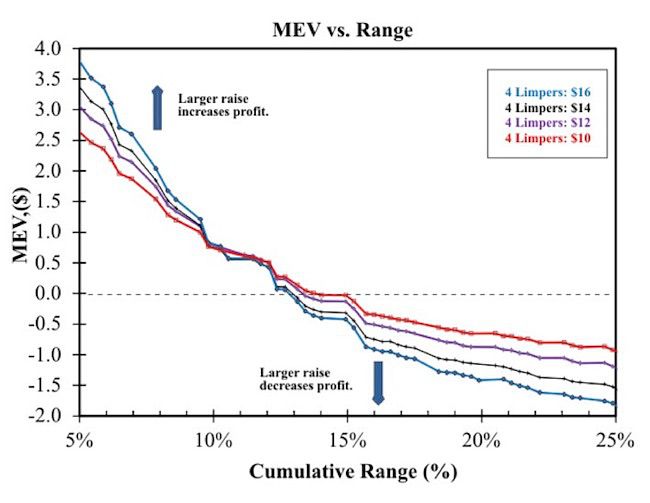
Here the symbols represent the MEV for raising to $10, $12, $14 or $16 in a Vegas $1/$2 game. These combos are sorted in order of MEVRaise.
The important thing to notice in this graph is that we have a much larger MEV when we raise our best hands by the maximum amount that will not result in a villain adjustment. If we have aces and the villains will call a $16 bet as often as a $10 bet, we should bet $16.
On the other hand, we should consider betting smaller with our borderline raising hands. Of course, this sets up the possibility that we could be telegraphing our hand strength. But most Vegas $1/$2 players are not paying much attention to our bet size unless the size is unusual for the table. Here we can make adjustments based on our knowledge of the players at our table.
Putting the Hero in the cutoff makes the analysis even more complex. Making some reasonable approximations, I can make a few generalizations:
We can't yet decide on a specific hand range for each scenario since we have not yet determined just how valuable our superior position and skill is. Nevertheless, it is clear that the more limpers we face, the tighter our raising raise should be.
Also, our raising range should be much wider than the typical Vegas player. We can also play from the cutoff facing X limpers with a similar range as from the button when facing X+1 limpers.
And of course, we should always adjust our ranges depending on the tendencies of the specific villains we face and based on specific tells we observe.
Steve Selbrede has been playing poker for 20 years and writing about it since 2012. He is the author of five books, The Statistics of Poker, Beat the Donks, Donkey Poker Volume 1: Preflop, Donkey Poker Volume 2: Postflop, and Donkey Poker Volume 3: Hand Reading.